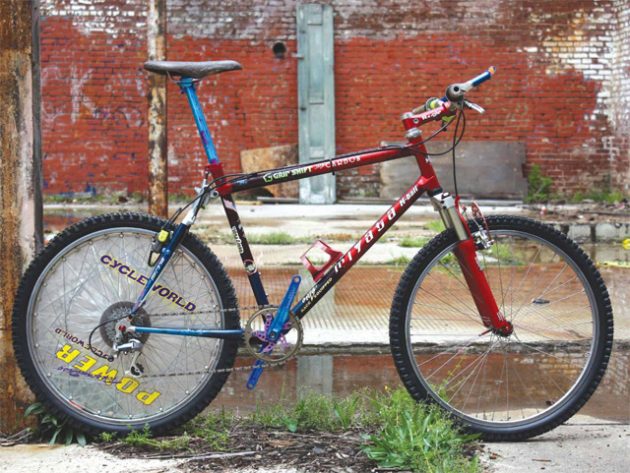Specialty Files: 1994 Miyata HB-Link
Originally posted on May 1, 2016 at 8:00 am
Words and photos: Jeff Archer
Pick up any early 1990s mountain-bike publication and odds are good you’ll see Greg “H-Ball” Herbold gracing its pages. It may be in the racing-results section, since he won the first UCI Downhill World Championship in 1990. He also won the NORBA Downhill National Championship in 1988, 1989 and 1993, as well as the North American Downhill Championship in 1991. Other racers of that era had similar results but were absent from the magazines. The differences were Greg’s oversized personality and his work with sponsors. Generally, sponsors are after three things: product development, visibility and promotion. H-Ball was very good at all three.
This bike shows off some of Greg’s product-development skills. The frame is one of only about a dozen carbon-fiber soft-tail bikes made by Miyata. Carbon-fiber tubes were bonded to aluminum lugs. The rear features about three-fourths of an inch of travel controlled by an AMP Research shock. The Onza bar ends are engraved “onZa proto 7-13-93,” belying their experimental status. The Kooka post and cranks feature a custom anodized splatter pattern. Brakes are a combination of Magura hydraulic rim on the rear and an Onza HO on the front, to help satisfy two sponsors. Ringlé supplied the front hub, skewers, water bottle cage and stem while SRAM Grip Shift X-Ray shifters handled the gear changes. The rear wheel is built with a tension disc that uses two stressed halves with Kevlar cords to replace the stainless steel spokes. The discs flexed quite a bit and when rolling at speed made a thunder you won’t forget.

Although H-Ball is no longer vying for world champ downhill stripes, he still keeps active in the cycling industry by working with SRAM on product development. While many fellow competitors have left the cycling industry for the “real world,” it speaks to the value of Greg’s input that he is still giving it close to two decades after leaving competition. This should be a good lesson to all the aspiring racers out there: Make sure to offer a good return on investment to your sponsors.
According to Herbold, “production never happened because head of engineering in Japan pulled the plug on the simple, effective and innovative design at the last minute, even after many samples were tested and all the marketing material was developed.”
This bike can be seen at the Museum of Mountain Bike Art & Technology, which is housed at First Flight Bicycles in historic downtown Statesville, North Carolina. If you can’t visit in person, check out the collection at MOMBAT.org.